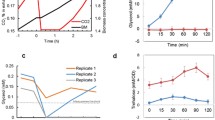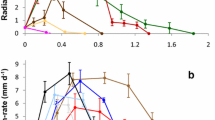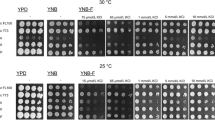Abstract
When exponentially growing Saccharomyces cerevisiae was transferred from a normal high water activity growth medium (aw 0.997) to a medium containing 8% NaCl low water activity growth medium (aw 0.955), glycerol accumulation during the first eight hours of the adaptation was both retarded and greatly diminished in magnitude. Investigation of the underlying reasons for the slow onset of glycerol accumulation revealed that not only was overall glycerol production reduced by salt transfer, but also the rates of ethanol production and glucose consumption were reduced. Measurement of glycolytic intermediates revealed an accumulation of glucose-6-phosphate, fructose-6-phosphate, fructose 1,6 bisphosphate and phosphoenolpyruvate in S. cerevisiae 3 to 4 h after transfer to salt, suggesting that one or more glycolytic enzymes were inhibited. Potassium ions accumulated in S. cerevisiae after salt transfer and reached a maximum about 6 h after transfer, whereas the sodium ion content increased progressively during the adaptation period. The trehalose content also increased in adapting cells. It is suggested that inhibition of glycerol production during the initial period of adaptation could be due to either the inhibition of glycerol-3-phosphate dehydrogenase by increased cation content or the inhibitin of glycolysis, glycerol being produced glycolytically in S. cerevisiae. The increased accumulation of glycerol towards the end of the 8-h period suggests that the osmoregulatory response of S. cerevisiae involves complex sets of adjustments in which inhibition of glycerol-3-phosphate dehydrogenase must be relieved before glycerol functions as a major osmoregulator.
Similar content being viewed by others
References
Adler L, Blomberg A, Nilsson A (1985) Glycerol metabolism and osmoregulation in the salt tolerant yeast D. hansenii. J Bacteriol 162:300–306
Anand JC, Brown AD (1968) Growth rate patterns of the so-called osmophilic and nonosmophilic yeasts in solutions of polyethylene glycol. J Gen Microbiol 52:205–212
Barnett JA, Payne RW, Yarrow D (1983) Yeasts: characteristic and identification. University Press, Cambridge
Beutler HO (1986) Ethanol. In: Bergmeyer HU (ed) Methods of enzymatic analysis. Verlag Chemie, Weinheim
Brown AD (1978) Compatible solutes and extreme water stress in eukaryotic microorganism. Adv Microb Physiol 17:181–242
Brown AD, Adgley MA (1980) Osmoregulation in yeast. In: Rains DW, Valentine RC, Hollander A (eds) Genetic engineering of osmoregulation. Plenum Press, New York, pp 75–90
Camacho M, Ramos J Rodriguez-Navarro A (1981) Potassium requirement of S. cerevisiae. Curr Microbiol 6:295–300
Ciriacy M, Breitenbach I (1979) Physiological effects of seven different blocks in glycolysis in S. cerevisiae. J Bacteriol 139:152–160
denHollander JA, Ugurbil K, Shulman RG (1986a) 31P and 13C NMR studies of intermediates of aerobic and anaerobic glycolysis in S. cerevisiae. Biochemistry 25:212–219
denHollander JA, Ugurbil K, Brown TR, Bednar M, Redfield C, Shulman RG (1986b) Studies of anaerobic and aerobic glycolysis in S. cerevisiae. Biochemistry 25:203–211
Edgley MA, Brown AD (1983) Yeast water relations: physiological changes induced by solute stress in S. cerevisiae and S. rouxii. J Gen Microbiol 129:3453–3463
Eggstein M, Kuhlman E (1974) Triglycerides and glycerol determination after alkaline hydrolysis. In: Bergmeyer HU (ed) Methods of enzymatic analysis. Academic Press, New York, pp 1825–1831
Gancedo C, Gancedo JM (1973) Concentrations of intermediate metabolites in yeast. Biochimie 55: 205–211
Gancedo C, Gancedo JM, Sols A (1968) Glycerol metabolism in yeast — pathways of utilization and production. Eur J Biochem 50:165–172
Lindman B, Norkrans B (1982) Membrane interrelationships —and ultrastructural study of the halotolerant yeast Debaryomyces hansenii. Protoplasma 110:66–70
Mackenzie KF, Blomberg A, Brown AD (1986) Water stress plating hypersensitivity of yeasts. J Gen Microbiol 132:2053–2056
Mackenzie KF, Singh KK, Brown AD (1988) Water stress plating hypersensitivity of yeasts: protective role of trehalose in S. cerevisiae. J Gen Microbiol 134:1661–1666
Nader W, Betz A, Becker J (1979) Partial purificaton, substrate specificity and regulation of α glycerol phosphate dehydrogenase from S. carlsbergensis. Biochim Biophys Acta 571:177–185
Navon G, Shulman RG, Yamane T, Eccleshall TR, Lam K, Baronofsky JJ, Marmur J (1979) 31P NMR studies of wild-type and glycolytic pathway mutants of S. cerevisiae. Biochemistry 8:4487–4499
Onishi H, Siromaru Y (1984) Physiological changes induced by salt stress in a salt tolerant soy yeast S. rouxii. FEMS Microbiology Lett 25:175–178
Norkrans B, Kylin A (1969) Regulation of the potassium to sodium ratio and of the osmotic potential in relation to salt tolerance in yeast. J Bacteriol 100:836–845
Stewart PR (1975) Analytical methods for yeasts. Methods Cell Biol 12:111–147
Author information
Authors and Affiliations
Rights and permissions
About this article
Cite this article
Singh, K.K., Norton, R.S. Metabolic changes induced during adaptation of Saccharomyces cerevisiae to a water stress. Arch. Microbiol. 156, 38–42 (1991). https://doi.org/10.1007/BF00418185
Received:
Accepted:
Issue Date:
DOI: https://doi.org/10.1007/BF00418185




